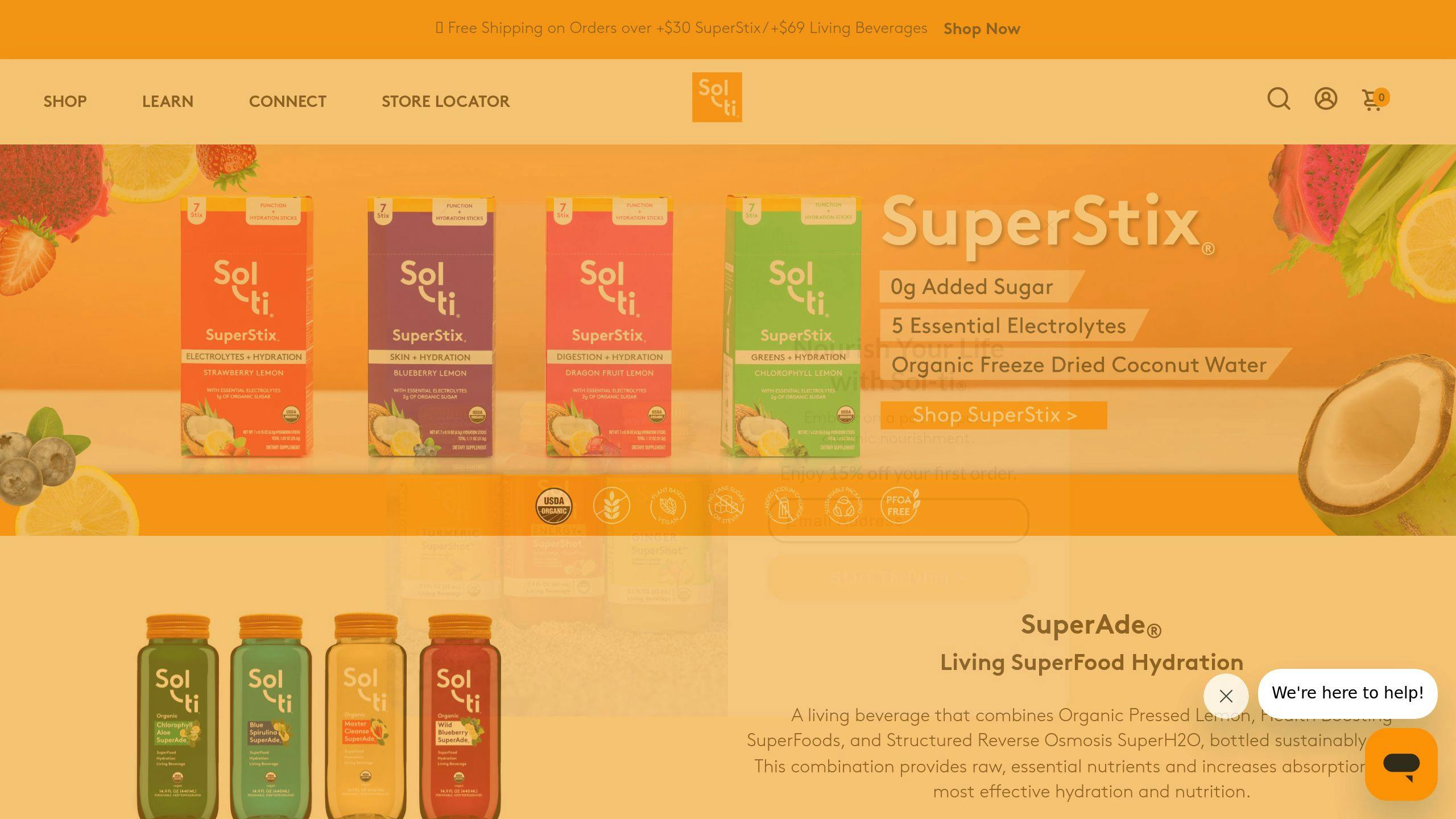- 8 Glasses a Day is a Myth: There's no universal rule for daily water intake. Your hydration needs depend on factors like activity, climate, and diet.
- Thirst is a Reliable Indicator: Thirst is an early warning system, not a sign of dehydration. Pay attention to your body’s signals like urine color and energy levels.
- Caffeine Doesn’t Dehydrate: Drinks like coffee and tea contribute to hydration when consumed in moderation.
- Overhydration is Risky: Drinking too much water can lead to hyponatremia, a dangerous drop in sodium levels. Balance is key.
- Food Helps Hydrate: Foods like fruits and vegetables can provide 20–40% of your daily fluid needs.
Quick Comparison of Hydration Myths vs Facts
| Myth | Fact |
|---|---|
| Everyone needs 8 glasses/day | Hydration needs vary by individual and include fluids from food. |
| Thirst means dehydration | Thirst is an early signal to maintain hydration balance. |
| Caffeine dehydrates you | Caffeinated drinks can hydrate when consumed in moderation. |
| No limit to water intake | Overhydration can lead to serious health risks like hyponatremia. |
Hydration isn’t one-size-fits-all. Listen to your body, adjust based on your lifestyle, and remember that food and various beverages contribute to staying hydrated.
The Hydration Myth: Do You Need 8 Glasses a Day?
Myth vs Fact: Daily Water Intake
Myth: 8 Glasses of Water Daily
The idea that everyone needs to drink "8 glasses of water a day" has been repeated so often it's taken as fact. However, this guideline doesn't have a solid scientific basis. It actually originates from a 1945 U.S. Food and Nutrition Board recommendation, which suggested people consume 2.5 liters of fluids daily. The key detail? That number included water from all sources - like food and other beverages - not just plain water [4].
This misunderstanding has led many to believe they need to drink more water than necessary.
Fact: Individual Hydration Needs
Hydration needs aren't one-size-fits-all. They depend on several factors:
| Factor | Impact on Hydration Needs | Consideration |
|---|---|---|
| Body Size & Activity | Larger bodies and more activity mean higher needs | Intake should reflect weight, body composition, and exercise level |
| Climate | Hot or humid weather increases water loss | Extra 500–1000ml may be needed in such conditions |
| Diet Composition | Foods high in water contribute significantly | Foods can supply 20–40% of daily water needs [2] |
Your body is equipped with mechanisms to regulate hydration naturally. For instance, an endurance athlete training in a hot climate will require much more water than someone with a desk job in a cooler environment. This variability highlights the importance of tailoring fluid intake to your specific lifestyle and conditions. As noted earlier, food plays a role in meeting hydration needs, with the remaining fluids coming from beverages adjusted to suit individual requirements.
Myth vs Fact: Thirst and Dehydration
Myth: Thirst Indicates Dehydration
There's a common belief that thirst is a sign you're already dehydrated. This idea often leads to rigid drinking schedules, overlooking the body's natural ability to regulate hydration. As mentioned earlier in the Daily Water Intake section, our bodies are equipped with a sophisticated system to maintain fluid balance.
Thirst is actually an early warning system, designed to keep your hydration levels in check. When your body senses even slight changes in fluid levels, it activates a series of biological processes to restore balance.
Fact: Signs of Proper Hydration
Instead of fearing thirst, use it as part of a broader set of physical indicators to assess hydration:
| System Component | Function | Response Time |
|---|---|---|
| Antidiuretic Hormone (ADH) | Signals kidneys to conserve water | Immediate response |
| Thirst Sensation | Encourages drinking behavior | Early signal |
| Kidney Function | Adjusts water retention | Ongoing regulation |
| Urine Color | Pale yellow suggests good hydration | Continuous indicator |
| Energy Levels | Stable energy throughout the day | Ongoing feedback |
| Mouth Feel | Moistness when hydrated | Immediate indicator |
| Mental Focus | Clear and alert thinking | Continuous feedback |
"Thirst is a helpful indicator, but some factors can increase fluid needs in children. An easy way to check for hydration is to look at a child's urine and adjust fluid intake from there." - Jessica Meuleners, Nutrition Field Specialist at South Dakota State University Extension [1]
The best approach is to respond to thirst promptly while factoring in your environment and activity level. Paying attention to cues like urine color and energy levels, along with thirst, helps ensure you stay properly hydrated.
sbb-itb-74fe2fe
Myth vs Fact: Caffeinated Drinks and Dehydration
Myth: Caffeine Causes Dehydration
The idea that caffeine dehydrates you is a bit of an overstatement - much like the outdated "8 glasses a day" rule. This myth likely comes from older studies that focused too much on caffeine's diuretic properties while ignoring the fluids in caffeinated drinks like coffee and tea.
Fact: Caffeine and Hydration
Research shows that caffeinated drinks can contribute to your daily hydration, as long as they're consumed in moderation. Studies indicate that drinking up to 400mg of caffeine a day (about 3-4 cups of coffee) has little effect on overall hydration levels.
| Beverage Type | Fluid Contribution | Caffeine Content | Hydration Value |
|---|---|---|---|
| Water | 100% | None | Fully Hydrating |
| Black Coffee | 95% | 95mg/8oz | Mildly Hydrating |
| Green Tea | 99% | 25-35mg/8oz | Hydrating |
| Black Tea | 98% | 14-70mg/8oz | Hydrating |
Here are some key points to keep in mind:
- Regular Drinkers: People who regularly drink coffee or tea tend to build a tolerance to caffeine's diuretic effects.
- Physical Activity: Even athletes can include caffeinated beverages in their routine without worrying about dehydration.
This perspective supports the idea that hydration needs vary by individual, much like the principles discussed in Overhydration Risks.
Myth vs Fact: Overhydration Risks
Myth: No Limit to Water Intake
Drinking too much water can be just as harmful as not drinking enough. Overconsumption may lead to a condition called hyponatremia, where sodium levels in the blood drop to dangerously low levels.
"It is possible to overhydrate and drink more than your body can flush out. It's a condition called hyponatremia, where sodium levels in the body become dangerously low" - Dr. Manveen Mann [3]
This highlights the risks of overhydration, contrasting it with caffeine-related myths. While moderate coffee consumption is generally fine, excessive water intake can lead to serious health issues.
Common signs of overhydration include:
- Mild symptoms: Headache, nausea
- Moderate symptoms: Confusion, muscle weakness
- Severe symptoms: Seizures, brain swelling
Fact: Hydration Balance
The idea that everyone needs the same amount of water daily is misleading. Hydration needs are personal and depend on factors like activity levels and electrolyte balance. This becomes especially crucial during exercise or long-duration activities.
| Activity Duration | Hydration Strategy | Electrolyte Consideration |
|---|---|---|
| Under 1 hour | Water only | Usually sufficient |
| 1-3 hours | Water + electrolytes | Moderate replacement needed |
| Over 3 hours | Planned electrolyte intake | Critical for proper balance |
Understanding your body's unique requirements can help maintain a healthy balance and avoid the risks of both underhydration and overhydration.
Eco-Friendly Hydration: Functional Beverages
Why Eco-Friendly Hydration Matters
The way we hydrate often comes with a hefty environmental price. On average, each American uses 167 plastic water bottles per year, with a staggering 80% ending up unrecycled [3][5]. This waste contributes to the 8 million tons of plastic polluting our oceans annually. The need for alternatives that prioritize both personal health and the environment has never been more urgent.
Sol-ti: A Sustainable Hydration Choice

Hydration isn’t one-size-fits-all, and neither are its environmental effects. Sol-ti has stepped up with a line of functional beverages that combine effective hydration and eco-conscious practices.
Here’s a look at their offerings:
| Product Line | Purpose | Features |
|---|---|---|
| SuperAde® | Hydration | Organic pressed lemon, structured water, glass packaging |
| SuperShot® | Immune Support | Superfood-packed, packaged in glass bottles |
| SuperStix® | Portable Hydration | Oceanic minerals, natural ingredients |
Why choose glass packaging? It offers some clear benefits over plastic:
- Eco-Friendly: Glass is fully recyclable and can be reused endlessly without losing quality.
- Taste Integrity: Unlike plastic, glass won’t leach chemicals or alter the flavor of your drink.
Sol-ti’s beverages go beyond hydration by using structured water and organic ingredients, ensuring you stay hydrated while reducing your environmental footprint. Opting for glass-packaged drinks is a simple yet impactful way to support both your health and the planet.
Conclusion: Debunking Hydration Myths
Key Points
Modern hydration research highlights the importance of paying attention to your own body's signals rather than following strict, one-size-fits-all rules. Studies show that hydration needs differ based on factors like activity level, climate, and individual physiology [2]. Interestingly, up to 40% of your daily water intake can come from food, depending on your diet [2].
"The water we get from food rarely exceeds 20% of our total water intake. Even if your diet is extremely high in fruits and vegetables and soups, you will rarely exceed probably 30 to 40% of your total water intake" - Professor Kavouras [2]
These insights build on earlier discussions about how caffeine intake and electrolytes play a role in hydration, especially during extended physical activity.
Hydration Tips
Here are some science-backed tips to help you stay hydrated effectively:
| Factor | What to Do | Example |
|---|---|---|
| Daily Intake | Let thirst and urine color guide you | Check urine color in the morning and evening |
| Climate | Drink more in hot weather | Add about 500ml when temperatures rise |
| Activity | Use electrolytes during long workouts | Try electrolyte drinks for activities lasting over an hour |
| Beverages | Mix up your fluid sources | Include water-rich foods and various drinks |
For those looking for convenient hydration options, Sol-ti’s SuperAde® drinks offer a mix of structured water and organic ingredients in glass bottles. Their SuperStix® packets are also a handy choice, delivering hydration with oceanic minerals for when you're on the move.


